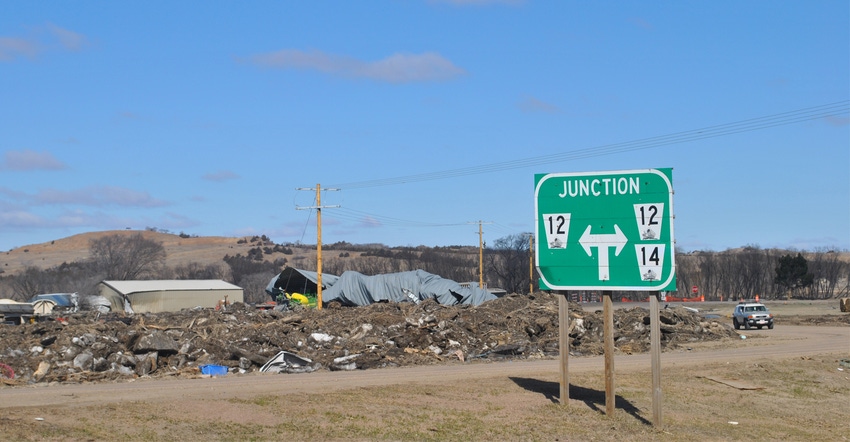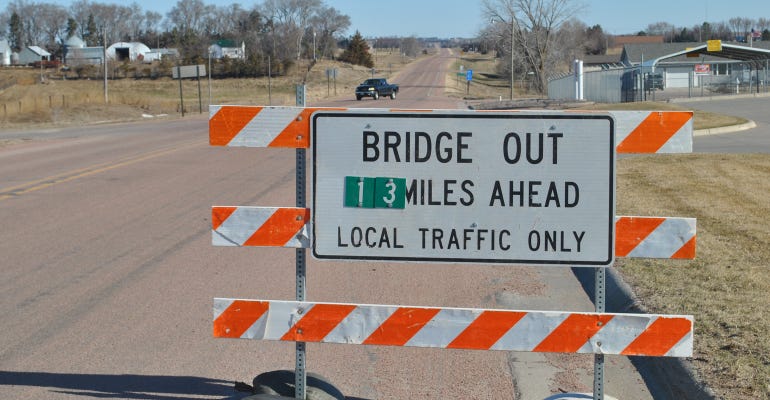
Massive flooding that began in the early morning hours of March 14 started a string of events that rocked the agriculture community, cities and towns across the state.
At the flood’s peak, more than 3,300 miles of state highway were closed because of a blizzard in the west and flooding in the east, meaning more than one-third of Nebraska’s roads were closed at one time.
The historic March flooding in Nebraska could be called a “farmers’ flood,” because of massive damage to farmland, farms and ranches and infrastructure crucial to agriculture. Bridges and roads are among the infrastructure that took the brunt of the flooding, with damage estimates at $100 million for the state highway system and $60 million to local roads on federal aid routes.
By late April, thanks to coordinated efforts by state highway workers and contractors, the roads that were affected had been whittled down to only 11 miles, but those were the toughest to repair. According to Nebraska Department of Transportation, 27 state bridges were affected by flooding, including six that need to be replaced, seven with significant damage and 14 with minor damage.
Two of the bridges that need to be replaced spanned the Niobrara River. The Morman Canal bridge on Highway 12 west of Niobrara and the approach to the Highway 281 bridge south of Spencer were washed away.
Area residents attending an early April NDOT meeting in Niobrara were informed that the Morman Canal bridge and Highway 281 bridge approach will be replaced with temporary bridges by August, and permanent bridges will be built by 2021.
The damage to the Niobrara River bridge and the loss of the adjacent Highway 12 Morman Canal bridge west of Niobrara mean that a trip to town that once took only minutes for residents living west of the river now takes an hour or more.
“Safety is our No. 1 priority,” NDOT director Kyle Schneweis told residents at the meeting. “We had to wait for the ice to clear. It took heavy equipment to move that out of the way. Then we had to wait for the water to go down, so our divers could do a proper assessment of the situation.”

BRIDGE OUT: Signs such as this one in Crofton, Neb., were common across the state in the wake of historic flooding in March. This sign indicates that a bridge on Highway 121 in northern Cedar County near Aten, Neb., was severely damaged during the flooding.

The Highway 281 bridge remains intact, but about a quarter mile of the approach was washed out, and the river took a new channel. “The road there is gone,” Schneweis said. “So now we have to build a bridge over that channel.”
An emergency contract was awarded to Hawkins Construction of Omaha on May 22 for work on the Highway 281 bridge. In a news release, Schneweis called this project, “one of the department’s most complex reconstruction efforts. We’ve followed a very aggressive schedule through design and procurement in order to expedite construction.”
This $25.47 million project calls for a single lane temporary road and bridge that should be in service by Aug. 1, and a permanent 1,050-foot bridge over the newly formed Niobrara River channel, scheduled for opening in November 2020 and completion by spring 2021.
On May 31, Hawkins Construction also received an emergency contract to repair the river bridge and install a temporary bridge over the Morman Canal west of Niobrara, while the permanent replacement is being built.
“For the Highway 12 bridge repair and Morman Canal bridge project west of Niobrara and the Highway 281 bridge project south of Spencer, the plans call for a one-lane temporary bridge,” said Vicki Kramer, NDOT. “Preliminary plans are for the Niobrara site to have 24-foot-wide temporary bridge and the Spencer site to have an 18-foot-wide temporary bridge. Both will be one lane, controlled by signal.”
Kramer said both temporary bridges will be capable of supporting all legal weight trucks and farm equipment. “The only limitation will be a 17-foot width restriction at the Spencer site, which may limit some agricultural traffic,” she said.
In addition, the existing Niobrara River bridge on the east side of the Morman Canal bridge will be load tested, so weight restrictions may be posted on that existing bridge, Kramer said. “NDOT will advertise and post restrictions prior to opening the temporary bridges up for traffic,” she added.
The bridges over the Niobrara River are just two examples of major road infrastructure projects being tackled this summer by state highway and county highway departments.
Graveled county and township roads and bridges have taken a hit as well. For much of the spring, miles of county roads have been impassable because of water over roads, washed out or damaged bridges and approaches and deep mud from excessive traffic. The situation has strained personnel and budgets of county road crews, and made movement of livestock, grain and machinery difficult.
“NDOT has a Local Assistance Division that works closely with locals on damages to federal aid routes,” Kramer said. “These reimbursements will come from the Federal Highway Administration and the scope of the projects and repairs are coordinated closely with the local entity, NDOT and FHWA,” she said. “Federal Emergency Management Agency also has a process for working with locals on roads and bridges off federal aid routes. NDOT has been and will continue to work with the Nebraska Emergency Management Agency and Nebraska Association of County Officials to support the needs of locals in whatever way we can.”
Learn more about updated flood recovery efforts at dot.nebraska.gov.
About the Author(s)
You May Also Like






